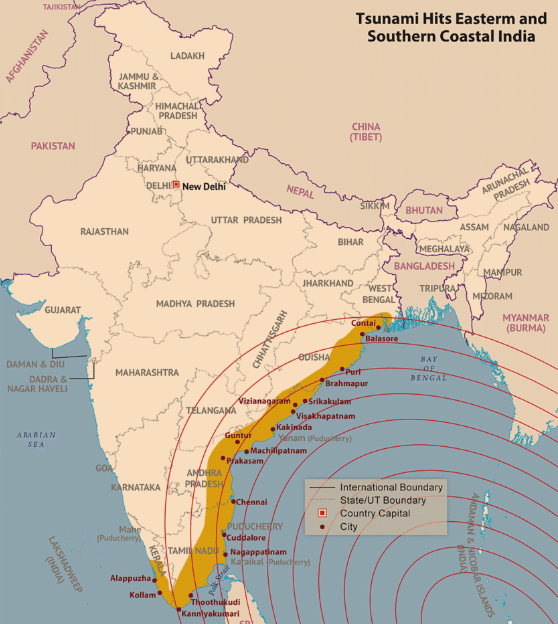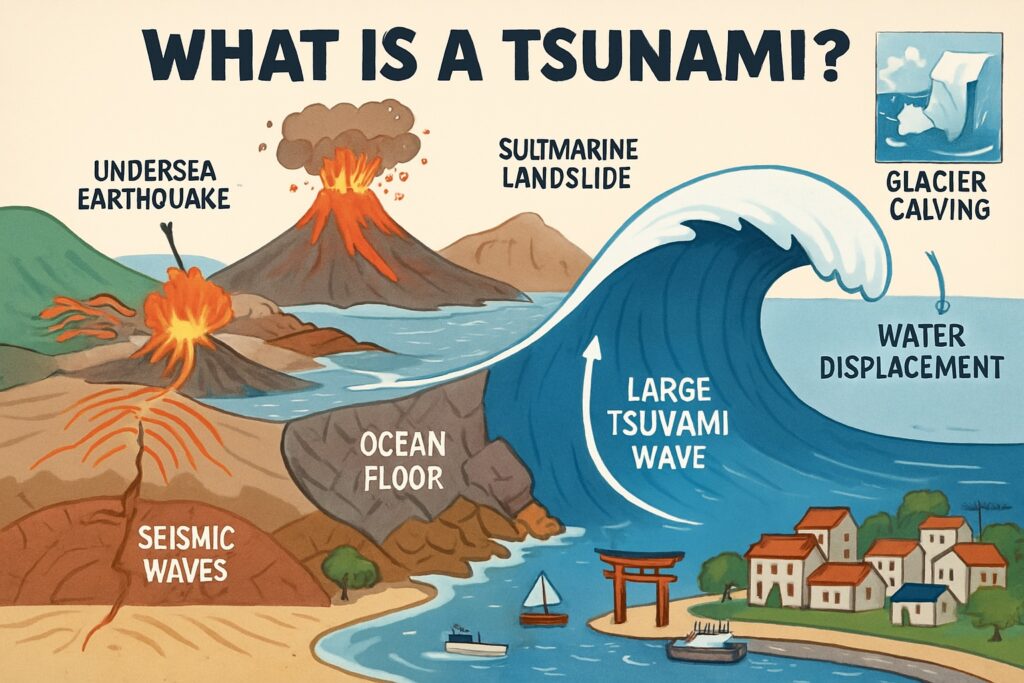A tsunami is a series of powerful sea waves caused by underwater disturbances such as earthquakes, volcanic eruptions, or landslides. These waves can travel across oceans at great speed and cause widespread destruction when they hit coastal areas. India, with its long coastline of over 7,500 km, is vulnerable to tsunamis, especially along the eastern coast and the Andaman & Nicobar Islands.

Table of Contents
What is a Tsunami?
The word “tsunami” comes from the Japanese words tsu (harbor) and nami (wave). It refers to large sea waves caused by sudden displacement of a large volume of water, usually triggered by:
- Undersea earthquakes
- Volcanic eruptions
- Submarine landslides
- Glacier calving (rarely)
Unlike regular waves, tsunamis are not caused by wind but by seismic activity under the sea.

Causes of Tsunami
- Submarine Earthquakes: Most common cause, especially when the ocean floor is uplifted or dropped suddenly.
- Volcanic Eruptions: Underwater volcanoes can displace water and cause tsunamis.
- Landslides into the Ocean: Can push large volumes of water.
- Meteorite Impacts: Rare but can create massive waves.
Tsunami-Prone Areas in India
India’s east coast is more vulnerable to tsunamis than the west coast due to proximity to the seismically active Andaman-Sumatra subduction zone.
- Andaman & Nicobar Islands
- Tamil Nadu (especially Nagapattinam, Chennai)
- Andhra Pradesh
- Odisha
- Puducherry
- Kerala (partially vulnerable)
The 2004 Indian Ocean Tsunami
One of the deadliest natural disasters in history, the 2004 tsunami originated from a massive undersea earthquake off the coast of Sumatra, Indonesia (Magnitude 9.1–9.3). It struck India on 26th December 2004.
- Indian states affected: Tamil Nadu, Andhra Pradesh, Kerala, and the Andaman & Nicobar Islands
- Death toll in India: Over 12,000
- Global toll: Around 230,000 people in 14 countries
- Damage: Massive loss of life, homes, fishing boats, and infrastructure
Effects of a Tsunami
- Massive flooding in coastal areas
- Loss of lives and livelihoods
- Destruction of property and infrastructure
- Salinization of soil and water sources
- Environmental damage (to mangroves, coral reefs, and ecosystems)
Tsunami Warning Systems in India
After the 2004 disaster, India established a dedicated tsunami warning center:
- Indian National Centre for Ocean Information Services (INCOIS), Hyderabad
- Part of the Indian Tsunami Early Warning System (ITEWS)
- Monitors seismic activity and ocean levels
- Sends alerts to coastal areas within minutes
Safety Measures and Preparedness
- Early Warning Alerts: Stay updated with alerts from INCOIS and the IMD.
- Evacuation Plans: Follow coastal evacuation routes to higher ground.
- Tsunami Education: Awareness programs for schools and coastal communities.
- Disaster-Resistant Infrastructure: Raised buildings and sea walls in vulnerable areas.
- Avoiding Coastal Construction: Limiting development in high-risk zones.
Conclusion
Tsunamis are rare but highly destructive events. India’s eastern coastline and island territories face the greatest risk due to their proximity to seismic zones. The tragic 2004 tsunami highlighted the need for early warning systems, better coastal planning, and community awareness. With strong preparedness and modern technology, India has taken significant steps to reduce future tsunami risks.
Read: Geography Notes